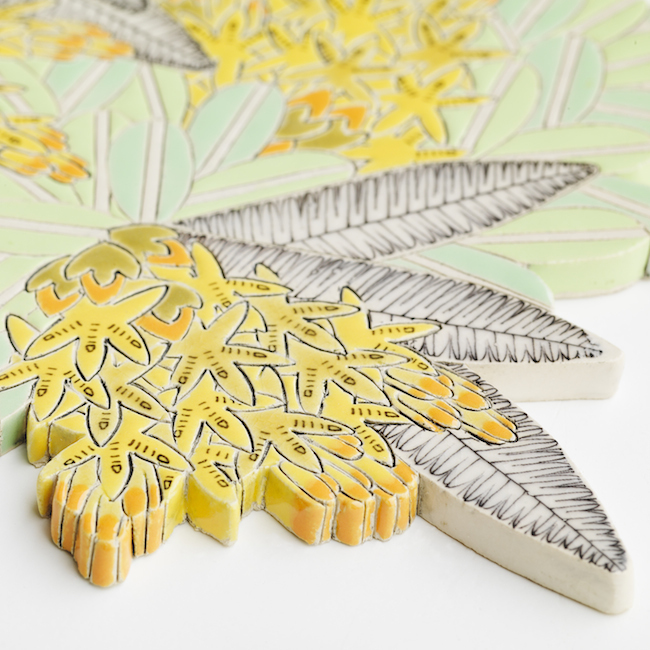An homage to the diverse and beautiful plant life on the Scottish island of Raasay, Patterns of Flora: Mapping Seven Raasay Habitats is a multidisciplinary project that combines decorative arts with vases, coloring books (which are very popular right now) and community outreach. The set was created by artist/designer Frances Priest in collaboration with botanist Stephen Bungard. It was commissioned by ATLAS Arts commission in Scotland.
The bespoke collection includes door handles, doorplates and tiles. They each reference one of seven diverse habitats on the island of Raasay: bog, coast, moor, freshwater, loch, mountain, limestone and woodland. These were permanently installed in the public areas of Raasay House. After taking in the ceramics, guests can pick up an illustrated map of walks across Raasay so they can find the plants for themselves. The House also installed a library of botanical books for guests to borrow and use. ATLAS also produced an edition of 150 parian vases and an edition of 300 coloring books, all of which feature Priest’s designs.
Priest said she is fascinated by “languages of ornament” from different cultures, places and periods in history. For the project, Priest wanted to develop her own language of ornament that drew from the Scottish landscape, distilling colors, textures, and forms into a collection of decorative motifs. She described her cross-discipline collaboration with Stephen Bungard, the botanist who helped her explore Raasay.
“Stephen spent a day introducing me to some of the habitats and plants of Raasay; Woodland, Coast, Moor, Bog, Loch, Limestone, Mountain. My usual experience of the Scottish landscape, striding out over significant distances to scale Munro’s and traverse ridges, was transformed, into a slower, detailed pace. My perspective shifted downward, away from grand vistas, toward the individual details of plants and flowers. Stephen’s interest in the flora of the islands began over 23 years ago and has developed into a full time vocation, covering an area of 1962 square kilometers that takes in Skye, Raasay and The Small Isles. His encyclopedic knowledge was inspirational and from this first meeting the seeds were sown for this project…”
Born in Wakefield, West Yorkshire, Frances came to Scotland to study ceramics at Edinburgh College of Art, according to her biography. She fell in love with the country and has remained in the capital after graduating from her degree course in 1998 and completing a post-graduate diploma. Frances’s work explores pattern and ornament in decorative art and design; where it is found, how it is used and the craft processes involved in its production. She creates intricately decorated ceramic forms, exploring and reinterpreting languages of ornament from different cultures, places and periods in history. This approach has led to projects in varied and sometimes unexpected settings, from a Tudor banqueting room in Sheffield, to an underpass in Cumbernauld.
Frances regularly exhibits work in the UK and overseas and her work is represented in national collections including, the National Museums of Scotland, Edinburgh, and the Victoria and Albert Museum, London. Her work is highly regarded internationally and can be found on sale in Edinburgh and at the Tansey Contemporary gallery in Santa Fe, in the USA.
What do you think of Priest’s decorative contemporary ceramic art? Let us know in the comments.

Frances Priest, Window Tile – Woodland. Photograph by Shannon Tofts.










Exquisite